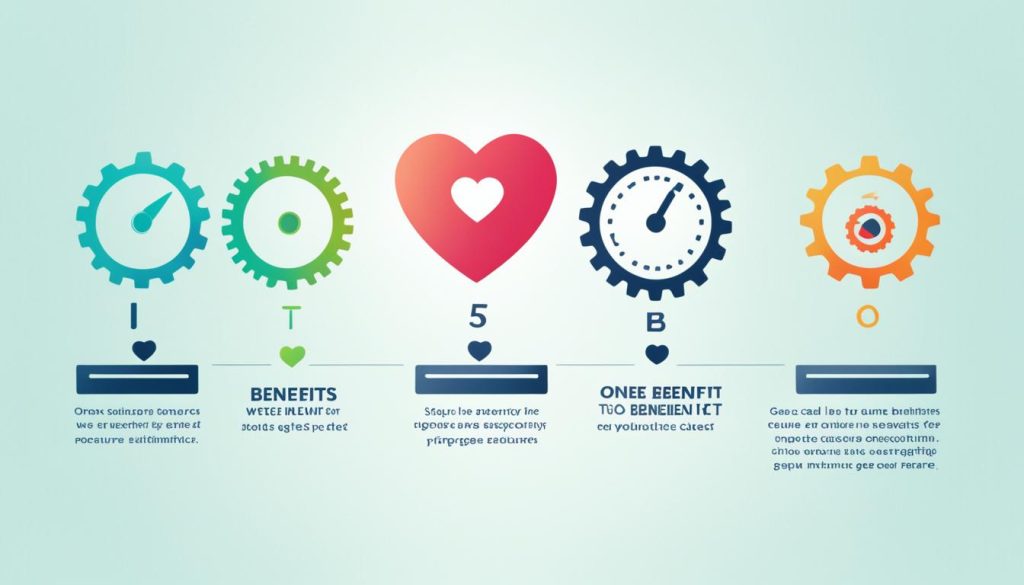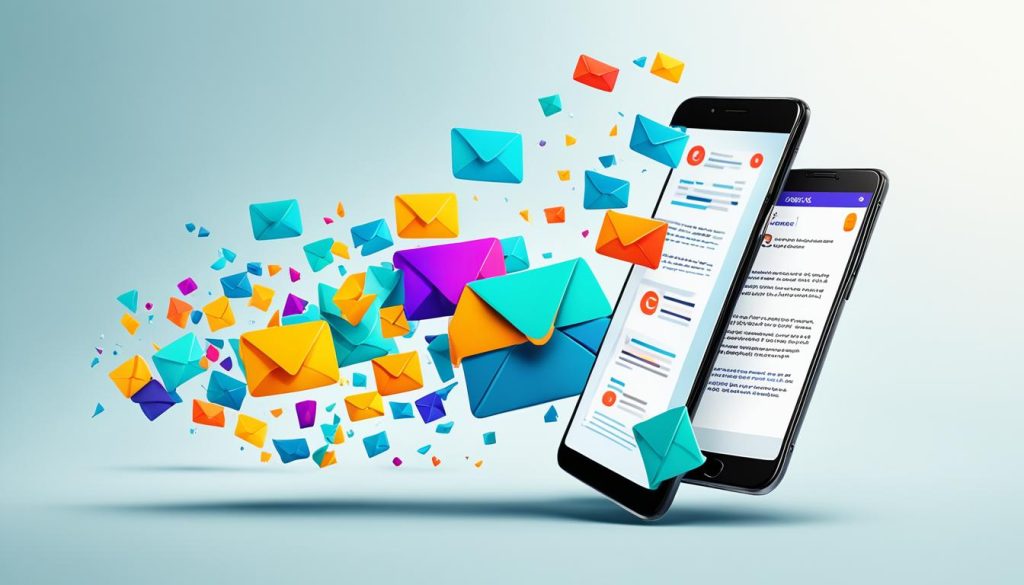Email marketing is growing fast. Understanding how to craft compelling content is key. What makes an email stand out? Is it a catchy subject line or the content that keeps readers interested? Let’s dive into how to create impactful marketing emails.
How to Write a Good Marketing Email
- Understand the importance of well-written content in email marketing.
- Explore best practices for crafting compelling subject lines to improve open rates.
- Learn effective copywriting tips for creating engaging email bodies.
- Discover the benefits of personalized email content and audience segmentation.
- Highlight the value and benefits offered in your marketing emails.
Best Practices for Writing Subject Lines
The subject line is key in effective email marketing. It can boost your email’s open rates. This leads to more engagement and higher click-through rates.
Actionable Language
Use action words in your subject lines. This creates urgency and pushes readers to act. Words like “Shop now,” “Limited time offer,” and “Get your discount” grab attention.
Personalization
Adding the recipient’s name or referencing past interactions makes subject lines more personal. Personalized subject lines get opened more often. This increases email engagement and the chance of making a sale.
Clarity
Subject lines should be clear and direct. Avoid being vague to prevent confusion. Explain the value or benefit of opening your email to spark interest.
Alignment with Email Content
Your subject line should match your email’s content. Avoid misleading titles that might increase opens but reduce interest later. A clear subject line builds trust and encourages further reading.
Emojis
Emojis make subject lines more appealing and expressive. But, use them wisely and make sure they match your email’s message and your brand’s style.
Testing Multiple Subject Lines
Dont’ stick to one subject line. Try out different ones to see what works best. A/B testing helps compare subject lines to optimize your approach with real data.
Using Numbers and Statistics
Numbers in subject lines catch the eye and seem reliable. Phrases like “5 proven strategies” or “Get 50% off” make emails more intriguing. Specific figures lure readers to learn more.
Avoiding All Caps
Don’t use all caps in subject lines; it feels like shouting and might set off spam filters. Capitalizing the first letter of each word or using sentence case looks professional and friendly.
Leveraging FOMO
FOMO can drive people to act. Adding urgency or a hint of exclusivity in your subject lines can make readers eager to open your emails. They won’t want to miss out on great deals or info.
Follow these tips to make your email subject lines effective. Doing so will improve your overall email marketing and lead to better open rates.
Copywriting Tips for Email Bodies
The content of your email is key to getting more clicks and improving conversions. To be great at writing emails, focus on these important strategies:
1. Writing in the Second Person
Use “you” and “your” to make emails feel more personal. This makes the reader feel special and connected to you.
2. Focusing on Benefits Rather Than Features
Don’t just list what your product does. Explain how it helps the reader. Showing the value of your offer makes people more likely to act.
3. Adopting a Conversational Tone
Write like you’re talking to a friend. Keep the tone casual and friendly. Stay away from formal words or jargon.
4. Creating Strong Call-to-Action (CTA)
Your CTA should be clear and direct. Tell readers exactly what you want them to do. Make sure your CTA stands out.
5. Incorporating Storytelling Techniques
Storytelling can create strong emotional ties with readers. Use real stories and experiences. This builds trust and keeps people engaged.


6. Optimizing for Mobile Devices
Many people read emails on their phones, so make your emails mobile-friendly. Use short paragraphs and bullet points. Always test your emails on various devices.
7. Testing and Refining
Keep testing and improving your emails. Try different versions to see what works best. Look at your data to make your emails better.
Following these tips can help you write emails that connect with subscribers. This can lead to more clicks and better conversions.
Creating Personalized Email Content
Email marketing works best when it’s relevant. Personalizing your emails helps you connect deeply with your audience. This will cover how to use audience segmentation to boost your email’s success.
The Importance of Audience Segmentation
Dividing your email list into smaller groups is called audience segmentation. You do this based on things like what people like and what they’ve done before. This way, you can make emails that really speak to each group’s needs.
You can get really personal, like using someone’s name or talking about their past with your brand. This makes your emails hit closer to home. It shows you get who your audience is, making your emails more relevant.
Addressing Recipients by Name
Calling people by their name in emails is a simple but effective trick. Whether in the subject line or the body of the email, it grabs their attention. It makes the email feel more like a one-to-one chat.
For example:
- “John, don’t miss out on our exclusive offer!”
- “Hey, Emma! We thought you might like this.”
Referencing Past Interactions
Talking about your subscribers’ past actions is another smart move. Mention their last purchase or something they did on your website. It shows you’re paying attention.
For instance:
- “We noticed you recently bought our XYZ product. Check out these related items.”
- “Thanks for joining our webinar! Here’s a special thank-you discount.”
Tailoring Content Based on Interests and Behaviors
Creating emails that match your audience’s likes and actions is key. Use your email platform or surveys to learn what they’re into. Then, send emails that fit exactly what they like.
If you sell clothes and know some customers love sports, send them deals on your new sports gear. They’ll likely appreciate it more.
Implementing Segmentation Strategies
You can segment your audience in many ways. Here are some criteria you might use:
- Demographics: Age, gender, location
- Interests: Hobbies, what they buy, what they like
- Engagement: How often they open emails or click on links
By sorting your email list using these, you can tailor your content for different groups.
The right tools and strategies can help you make emails that really talk to what your audience wants. Putting focus on making content relevant will make your email marketing more successful. You’ll see better open and click-through rates.
Highlighting Benefits and Solving Problems
Creating effective marketing emails means focusing on the perks. It’s not just about what your product does. It’s about how it makes life better for your readers. Show them how your product or service fixes a problem or improves their day, and they’ll be more likely to act.
Don’t just talk about what your product or service does. Explain why that matters. Think about the problems it solves or how it makes things easier or more fun for your customers. Answering these questions makes your email more appealing and can make readers excited.
Telling stories of real customers who benefitted can be powerful. It shows proof and helps readers connect emotionally. They see others’ success, and it makes them hopeful for the same results.
Write in a way that touches your readers’ hearts. Show them how your product can ease their troubles, save time, boost their health, or help them reach goals. Make them see the big difference your product or service can make, and why they should want it.
The secret to emails that persuade is to show you get what your audience needs and wants. Highlight the good stuff and show how you solve problems. This way, you draw readers in and push them towards making a move.


| Features | Benefits |
|---|---|
| Advanced encryption technology | Ensures the security and privacy of your data |
| 24/7 customer support | Receive assistance at any time, solving issues promptly |
| User-friendly interface | Easily navigate and use the platform without technical expertise |
| Automatic updates | Stay up-to-date with new features and improvements |
| Flexible pricing plans | Choose the plan that best fits your needs and budget |
Using Conversational Tone and Brand Voice
People love emails that sound like a chat with a friend. This style makes your readers feel at ease. It helps to form solid connections. Ultimately, it can turn your audience into devoted customers.
Put in a pinch of personal touch to your emails. Avoid stiff words and technical terms. Pretend you’re having a warm chat with a buddy. This tactic makes your message more inviting.
It’s crucial to keep your unique brand voice alive in all messages. Your voice showcases your brand’s identity. Whether you’re funny, serious, or lively, let your emails reflect this. It ensures a consistent and unforgettable experience.
Using both conversational tone and your brand’s voice deepens subscriber relationships. Your audience will feel more appreciated and seen. This can lead to better interactions and more sales. So, let your brand’s true colors show in your emails.
Now, see how some brands excellently blend conversational tones and brand voices in their emails:
Example 1: Lifestyle Clothing Brand
| Subject Line | Email Body |
|---|---|
| Get Ready for Summer with Our New Collection |
Hey there! Summer is almost here, and it’s time for a wardrobe update. Our latest clothing line is here to brighten your look. We offer everything from light dresses to cool tops. Perfect for summer fun. Look great whether you’re poolside or on a trip. Eager for summer? Visit our site and shop now! Stay cool and trendy, The Lifestyle Clothing Team |
Example 2: Tech Startup
| Subject Line | Email Body |
|---|---|
| Unlock the Power of Productivity with Our Latest App Update |
Hi there! We’re thrilled to share a big update for our productivity app. It’s designed to change how you work. Thanks to your input, we’ve fixed bugs and added awesome features. We aim to help you stay organized and achieve more. Why wait? Update your app now for a productivity surge. Wishing you a productive day, The Tech Startup Team |
Optimizing Email Content for Mobile Devices
Many emails today are opened on mobile devices. This makes it critical to ensure your email content is mobile-friendly. By doing so, the mobile user experience improves, leading to higher engagement and conversion rates.
1. Use Short Paragraphs
Long paragraphs can be daunting on small screens, causing readers to lose interest quickly. It’s better to use short paragraphs. This makes your content easier to read and understand.
2. Scannable Text
Help mobile users by making your email easy to scan. Use headings, subheadings, and bullet points. This way, they can quickly get the gist and navigate your content with ease.
3. Legible Fonts
Choose fonts that are easy to read on small screens. Stay away from small or fancy fonts. A good rule is to use a font size of at least 14 pixels. This helps in ensuring your text is readable.


4. Test Across Devices
Make sure to test your emails on different mobile devices and email clients. This ensures they look good and are readable everywhere. Testing helps you find and fix any issues with layout or formatting.
| Email Metrics | Desktop | Mobile |
|---|---|---|
| Open Rate | 30% | 48% |
| Click-through Rate | 5% | 10% |
| Conversion Rate | 2% | 6% |
Optimizing your email for mobile devices boosts the user experience. It also drives better results in your email marketing campaigns.
Testing and Refining Email Copy
When you start an email marketing campaign, tracking how well your emails do is key. A/B testing lets you try out different parts of your email. This helps you find out what works best.
A/B testing in email marketing:
Think about A/B testing to better your email’s performance. Testing different parts like subject lines, content, and calls to action (CTAs) can show you what your audience likes. You send out two versions and see which one does better.
Here are parts of your email you can test:
- Subject lines: Try different subject lines to see which get more opens. Use variations in how long they are, the tone, if they’re personalized, and include important keywords.
- Body content: Change how your email sounds and looks. See how these changes affect if people click through. Test different ways of writing, how long your email is, how it’s set up, and how noticeable your CTA is.
- CTAs: See how different CTAs affect if people take the action you want. Change the words, colors, where they’re placed, and how they look to find the best one for your emails.
Interpreting A/B testing results
Look at your A/B test results with your goals in mind. Check if changes lead to better results. Look for big differences between your test emails and the original ones.
If you want more people to open your emails, compare the open rates. A higher rate in the test version means your change worked. Do the same with click-through rates and conversions to see what gets more people involved.
Also, pay attention to what your customers say and do. Watching how people react to your emails gives you more clues about what they like. Once you find what works, use it in your future emails to get better results.
Understanding your audience is crucial for email marketing. A/B testing gives you the insights to make your emails more engaging. This can lead to better engagement and more conversions.
Conclusion
Writing great emails means paying attention to small details, knowing your audience, and using the right copywriting tricks. When you use the tips from this article, your email content will surely hit the mark with your subscribers.
Your emails need eye-catching subject lines to make readers want to open them. The main part of your email should talk about how your product or service can help. Speak like you’re having a chat and stay true to your brand’s voice to connect with your subscribers.
Since many people read emails on their phones, your emails must look good on smaller screens. Make your emails easy to read by keeping paragraphs short. Also, fonts should be clear. Regular testing helps you get better at creating emails, so do A/B tests often.
Using these tips and focusing on every detail of your email can lead to stellar emails that persuade and entertain. Good email content gets your audience’s attention and turns them into devoted buyers. Remember, your success in email marketing relies on crafting content that speaks directly to your audience.


